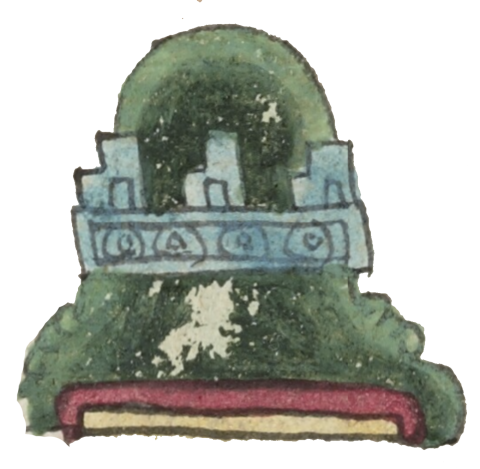Tenanyocan (Mdz2r)
This compound glyph for the place name Tenanyocan has two principal features. One is a wall or rampart (tenamitl) painted turquoise blue. Typical of this type of wall, it has upper parts that are reminiscent of crenellation, with stepped rectangular shapes. The main part of the wall is a horizontal piece, decorated with row of four small, concentric circles. The other dominant feature of this glyph is a mountain that is a typical bell shape, painted two-tone green (lighter toward the exterior), with curly rocky outcroppings also on the exterior, and a horizontal yellow and red stripe at the base of the mountain. The suffix -yo- (giving a noun that inherent characteristic) and the suffix -can (a locative, saying where) are not shown visually.
Stephanie Wood
The -yo- suggests that this is a place characterized by walls or ramparts, hence the interpretation of Berdan and Anawalt that the town is "full of walls."
Stephanie Wood
tenayucan.pueblo/
Tenanyocan, pueblo (modern-day Tenayuca)
Stephanie Wood
by 1553 at the latest
Stephanie Wood
hills, mountains, cerros, montañas, walls, ramparts, crenellation, paredes, murallas, almena, almenas, merlons, cresterías, nombres de lugares

tenami(tl), wall(s), rampart(s), https://nahuatl.wired-humanities.org/content/tenamitl
-yocan, place where there is a lot of (the preceding noun), https://nahuatl.wired-humanities.org/content/yocan
-yo(tl)-, having that characteristic or quality/inalienable possession, https://nahuatl.wired-humanities.org/content/yotl
-can (locative suffix), where, https://nahuatl.wired-humanities.org/content/can-2
"Place Full of Walls" (apparently agreeing with Berdan and Anawalt) [Frances Karttunen, unpublished manuscript, used here with her permission.]
"Place Full of Walls" (Berdan and Anawalt, 1992, vol. 1, p. 208)
"Donde Hay Muchas Murallas" o "Donde Hay Muchos Paredes"
Stephanie Wood
Codex Mendoza, folio 2 recto, https://codicemendoza.inah.gob.mx/inicio.php?lang=english
Original manuscript is held by the Bodleian Libraries, University of Oxford, MS. Arch. Selden. A. 1; used here with the UK Creative Commons, “Attribution-NonCommercial-ShareAlike 3.0 License” (CC-BY-NC-SA 3.0)





